
Question Number 2796 by Rasheed Soomro last updated on 27/Nov/15
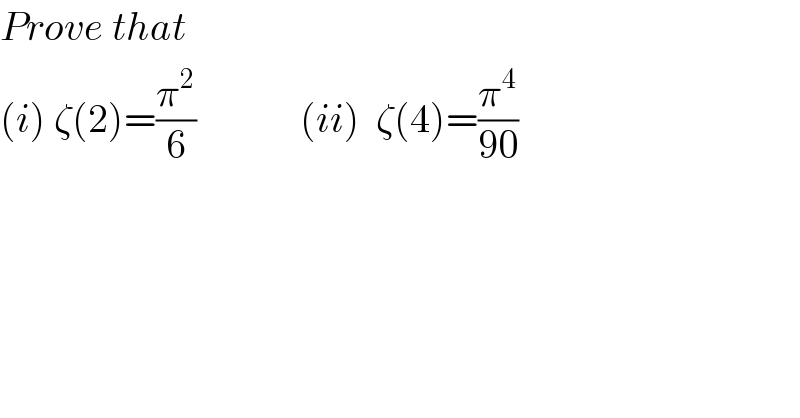
$${Prove}\:{that} \\ $$$$\left({i}\right)\:\zeta\left(\mathrm{2}\right)=\frac{\pi^{\mathrm{2}} }{\mathrm{6}}\:\:\:\:\:\:\:\:\:\:\:\:\:\left({ii}\right)\:\:\zeta\left(\mathrm{4}\right)=\frac{\pi^{\mathrm{4}} }{\mathrm{90}} \\ $$
Answered by prakash jain last updated on 28/Nov/15
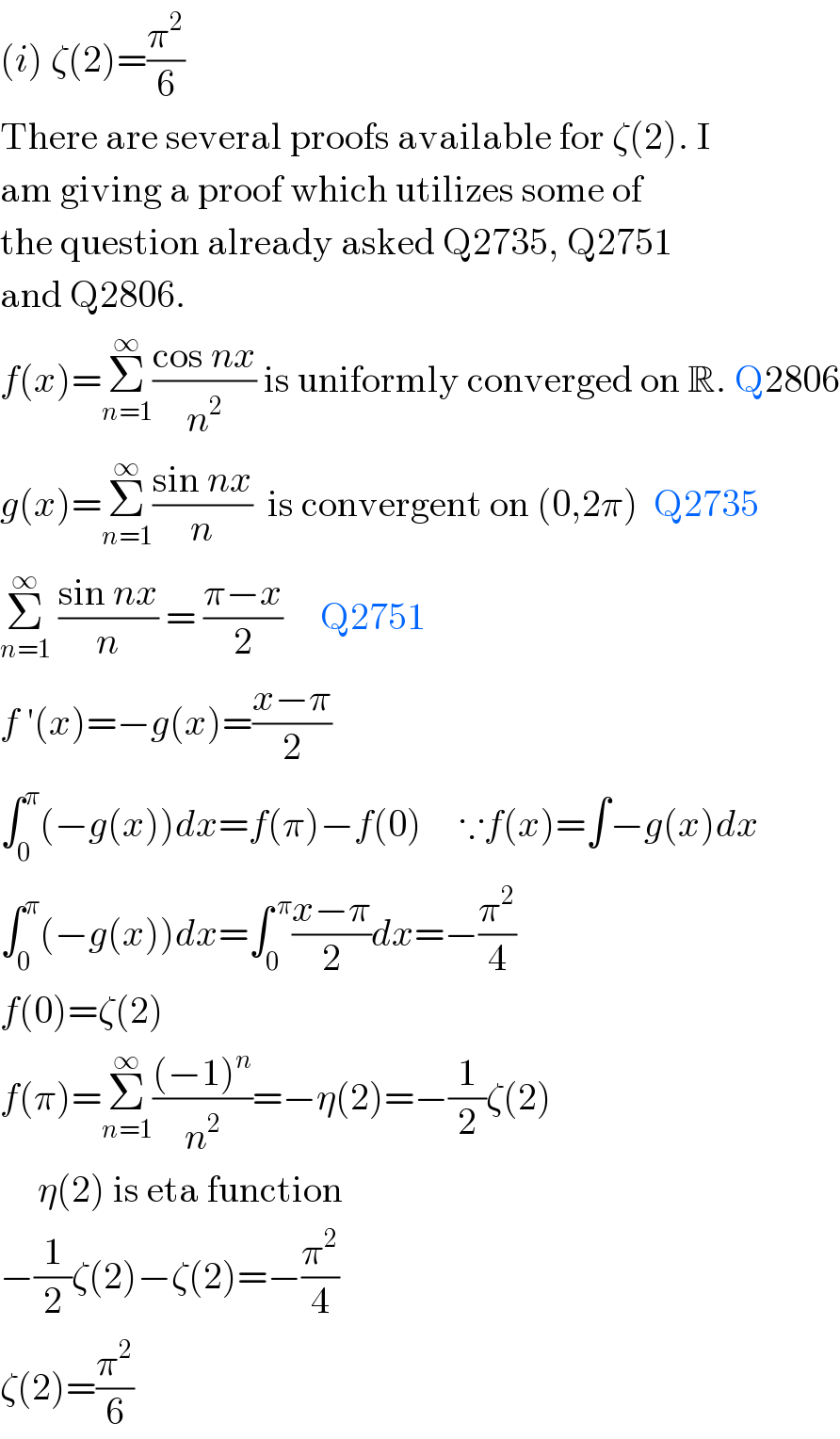
$$\left({i}\right)\:\zeta\left(\mathrm{2}\right)=\frac{\pi^{\mathrm{2}} }{\mathrm{6}} \\ $$$$\mathrm{There}\:\mathrm{are}\:\mathrm{several}\:\mathrm{proofs}\:\mathrm{available}\:\mathrm{for}\:\zeta\left(\mathrm{2}\right).\:\mathrm{I} \\ $$$$\mathrm{am}\:\mathrm{giving}\:\mathrm{a}\:\mathrm{proof}\:\mathrm{which}\:\mathrm{utilizes}\:\mathrm{some}\:\mathrm{of} \\ $$$$\mathrm{the}\:\mathrm{question}\:\mathrm{already}\:\mathrm{asked}\:\mathrm{Q2735},\:\mathrm{Q2751} \\ $$$$\mathrm{and}\:\mathrm{Q2806}. \\ $$$${f}\left({x}\right)=\underset{{n}=\mathrm{1}} {\overset{\infty} {\sum}}\frac{\mathrm{cos}\:{nx}}{{n}^{\mathrm{2}} }\:\mathrm{is}\:\mathrm{uniformly}\:\mathrm{converged}\:\mathrm{on}\:\mathbb{R}.\:\mathrm{Q2806} \\ $$$${g}\left({x}\right)=\underset{{n}=\mathrm{1}} {\overset{\infty} {\sum}}\frac{\mathrm{sin}\:{nx}}{{n}}\:\:\mathrm{is}\:\mathrm{convergent}\:\mathrm{on}\:\left(\mathrm{0},\mathrm{2}\pi\right)\:\:\mathrm{Q2735} \\ $$$$\underset{{n}=\mathrm{1}} {\overset{\infty} {\sum}}\:\frac{\mathrm{sin}\:{nx}}{{n}}\:=\:\frac{\pi−{x}}{\mathrm{2}}\:\:\:\:\:\mathrm{Q2751} \\ $$$${f}\:'\left({x}\right)=−{g}\left({x}\right)=\frac{{x}−\pi}{\mathrm{2}} \\ $$$$\int_{\mathrm{0}} ^{\pi} \left(−{g}\left({x}\right)\right){dx}={f}\left(\pi\right)−{f}\left(\mathrm{0}\right)\:\:\:\:\:\because{f}\left({x}\right)=\int−{g}\left({x}\right){dx} \\ $$$$\int_{\mathrm{0}} ^{\pi} \left(−{g}\left({x}\right)\right){dx}=\int_{\mathrm{0}} ^{\:\pi} \frac{{x}−\pi}{\mathrm{2}}{dx}=−\frac{\pi^{\mathrm{2}} }{\mathrm{4}}\:\:\: \\ $$$${f}\left(\mathrm{0}\right)=\zeta\left(\mathrm{2}\right) \\ $$$${f}\left(\pi\right)=\underset{{n}=\mathrm{1}} {\overset{\infty} {\sum}}\frac{\left(−\mathrm{1}\right)^{{n}} }{{n}^{\mathrm{2}} }=−\eta\left(\mathrm{2}\right)=−\frac{\mathrm{1}}{\mathrm{2}}\zeta\left(\mathrm{2}\right) \\ $$$$\:\:\:\:\:\eta\left(\mathrm{2}\right)\:\mathrm{is}\:\mathrm{eta}\:\mathrm{function} \\ $$$$−\frac{\mathrm{1}}{\mathrm{2}}\zeta\left(\mathrm{2}\right)−\zeta\left(\mathrm{2}\right)=−\frac{\pi^{\mathrm{2}} }{\mathrm{4}} \\ $$$$\zeta\left(\mathrm{2}\right)=\frac{\pi^{\mathrm{2}} }{\mathrm{6}} \\ $$
Answered by 123456 last updated on 27/Nov/15
![(ii) ζ(4) (Σ_(n=1) ^(+∞) (1/n^s ))^2 =Σ_(n=1) ^(+∞) (1/n^(2s) )+2Σ_(n=1) ^(+∞) Σ_(m=n+1) ^(+∞) (1/((nm)^s )) [ζ(s)]^2 =ζ(2s)+2Σ_(n=1) ^(+∞) Σ_(m=n+1) ^(+∞) (1/((nm)^s )) ζ(4)=[ζ(2)]^2 −2Σ_(n=1) ^(+∞) Σ_(m=n+1) ^(+∞) (1/((nm)^2 )) =[(π^2 /6)]^2 −2∙(π^4 /(120)) =(π^4 /(36))−(π^4 /(60)) =(((60−36)π^4 )/(36×60)) =((24π^4 )/(36×60)) =((6π^4 )/(18×30)) =(π^4 /(9×10)) =(π^4 /(90)) −−−−−detail in comment−−−−−](Q2823.png)
$$\left({ii}\right)\:\zeta\left(\mathrm{4}\right) \\ $$$$\left(\underset{{n}=\mathrm{1}} {\overset{+\infty} {\sum}}\frac{\mathrm{1}}{{n}^{{s}} }\right)^{\mathrm{2}} =\underset{{n}=\mathrm{1}} {\overset{+\infty} {\sum}}\:\frac{\mathrm{1}}{{n}^{\mathrm{2}{s}} }+\mathrm{2}\underset{{n}=\mathrm{1}} {\overset{+\infty} {\sum}}\:\underset{{m}={n}+\mathrm{1}} {\overset{+\infty} {\sum}}\frac{\mathrm{1}}{\left({nm}\right)^{{s}} } \\ $$$$\left[\zeta\left({s}\right)\right]^{\mathrm{2}} =\zeta\left(\mathrm{2}{s}\right)+\mathrm{2}\underset{{n}=\mathrm{1}} {\overset{+\infty} {\sum}}\:\underset{{m}={n}+\mathrm{1}} {\overset{+\infty} {\sum}}\frac{\mathrm{1}}{\left({nm}\right)^{{s}} } \\ $$$$\zeta\left(\mathrm{4}\right)=\left[\zeta\left(\mathrm{2}\right)\right]^{\mathrm{2}} −\mathrm{2}\underset{{n}=\mathrm{1}} {\overset{+\infty} {\sum}}\:\underset{{m}={n}+\mathrm{1}} {\overset{+\infty} {\sum}}\frac{\mathrm{1}}{\left({nm}\right)^{\mathrm{2}} } \\ $$$$=\left[\frac{\pi^{\mathrm{2}} }{\mathrm{6}}\right]^{\mathrm{2}} −\mathrm{2}\centerdot\frac{\pi^{\mathrm{4}} }{\mathrm{120}} \\ $$$$=\frac{\pi^{\mathrm{4}} }{\mathrm{36}}−\frac{\pi^{\mathrm{4}} }{\mathrm{60}} \\ $$$$=\frac{\left(\mathrm{60}−\mathrm{36}\right)\pi^{\mathrm{4}} }{\mathrm{36}×\mathrm{60}} \\ $$$$=\frac{\mathrm{24}\pi^{\mathrm{4}} }{\mathrm{36}×\mathrm{60}} \\ $$$$=\frac{\mathrm{6}\pi^{\mathrm{4}} }{\mathrm{18}×\mathrm{30}} \\ $$$$=\frac{\pi^{\mathrm{4}} }{\mathrm{9}×\mathrm{10}} \\ $$$$=\frac{\pi^{\mathrm{4}} }{\mathrm{90}} \\ $$$$−−−−−\mathrm{detail}\:\mathrm{in}\:\mathrm{comment}−−−−− \\ $$
Commented by 123456 last updated on 27/Nov/15
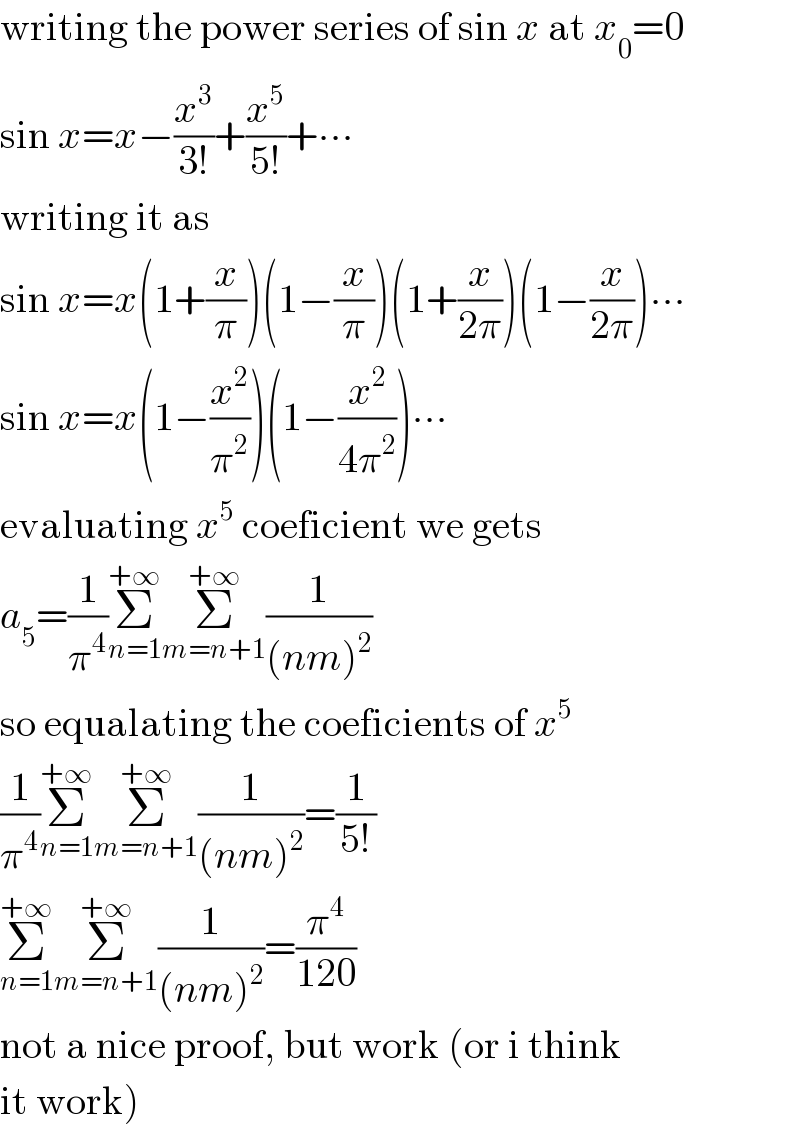
$$\mathrm{writing}\:\mathrm{the}\:\mathrm{power}\:\mathrm{series}\:\mathrm{of}\:\mathrm{sin}\:{x}\:\mathrm{at}\:{x}_{\mathrm{0}} =\mathrm{0} \\ $$$$\mathrm{sin}\:{x}={x}−\frac{{x}^{\mathrm{3}} }{\mathrm{3}!}+\frac{{x}^{\mathrm{5}} }{\mathrm{5}!}+\centerdot\centerdot\centerdot\: \\ $$$$\mathrm{writing}\:\mathrm{it}\:\mathrm{as} \\ $$$$\mathrm{sin}\:{x}={x}\left(\mathrm{1}+\frac{{x}}{\pi}\right)\left(\mathrm{1}−\frac{{x}}{\pi}\right)\left(\mathrm{1}+\frac{{x}}{\mathrm{2}\pi}\right)\left(\mathrm{1}−\frac{{x}}{\mathrm{2}\pi}\right)\centerdot\centerdot\centerdot \\ $$$$\mathrm{sin}\:{x}={x}\left(\mathrm{1}−\frac{{x}^{\mathrm{2}} }{\pi^{\mathrm{2}} }\right)\left(\mathrm{1}−\frac{{x}^{\mathrm{2}} }{\mathrm{4}\pi^{\mathrm{2}} }\right)\centerdot\centerdot\centerdot \\ $$$$\mathrm{evaluating}\:{x}^{\mathrm{5}} \:\mathrm{coeficient}\:\mathrm{we}\:\mathrm{gets} \\ $$$${a}_{\mathrm{5}} =\frac{\mathrm{1}}{\pi^{\mathrm{4}} }\underset{{n}=\mathrm{1}} {\overset{+\infty} {\sum}}\underset{{m}={n}+\mathrm{1}} {\overset{+\infty} {\sum}}\frac{\mathrm{1}}{\left({nm}\right)^{\mathrm{2}} } \\ $$$$\mathrm{so}\:\mathrm{equalating}\:\mathrm{the}\:\mathrm{coeficients}\:\mathrm{of}\:{x}^{\mathrm{5}} \\ $$$$\frac{\mathrm{1}}{\pi^{\mathrm{4}} }\underset{{n}=\mathrm{1}} {\overset{+\infty} {\sum}}\underset{{m}={n}+\mathrm{1}} {\overset{+\infty} {\sum}}\frac{\mathrm{1}}{\left({nm}\right)^{\mathrm{2}} }=\frac{\mathrm{1}}{\mathrm{5}!} \\ $$$$\underset{{n}=\mathrm{1}} {\overset{+\infty} {\sum}}\underset{{m}={n}+\mathrm{1}} {\overset{+\infty} {\sum}}\frac{\mathrm{1}}{\left({nm}\right)^{\mathrm{2}} }=\frac{\pi^{\mathrm{4}} }{\mathrm{120}} \\ $$$$\mathrm{not}\:\mathrm{a}\:\mathrm{nice}\:\mathrm{proof},\:\mathrm{but}\:\mathrm{work}\:\left(\mathrm{or}\:\mathrm{i}\:\mathrm{think}\right. \\ $$$$\left.\mathrm{it}\:\mathrm{work}\right) \\ $$
Commented by Rasheed Soomro last updated on 30/Nov/15

$$\mathcal{D}{etermining}\:{coefficient}\:{of}\:{x}^{\mathrm{5}} \:{from} \\ $$$${sin}\:{x}={x}\left(\mathrm{1}+\frac{{x}}{\pi}\right)\left(\mathrm{1}−\frac{{x}}{\pi}\right)\left(\mathrm{1}+\frac{{x}}{\mathrm{2}\pi}\right)\left(\mathrm{1}−\frac{{x}}{\mathrm{2}\pi}\right)... \\ $$$${is}\:{too}\:{complicated}! \\ $$
Commented by 123456 last updated on 01/Dec/15

$$\mathrm{there}\:\mathrm{no}\:\mathrm{need}\:\mathrm{for}\:\mathrm{this},\:\mathrm{use}\:\mathrm{the}\:\mathrm{fact} \\ $$$$\left({a}+{b}\right)\left({a}−{b}\right)={a}^{\mathrm{2}} −{b}^{\mathrm{2}} \\ $$$$\mathrm{wich}\:\mathrm{turn}\:\mathrm{more}\:\mathrm{easy}\:\mathrm{the}\:\mathrm{determination} \\ $$
Commented by Rasheed Soomro last updated on 01/Dec/15

$${Will}\:\:{only}\:{first}\:{five}\:{factors}\:{make}\:{the}\:{term}\:{containing} \\ $$$${x}^{\mathrm{5}} \:?\:{The}\:{remaining}\:{factors}\:{have}\:{no}\:{effect}\:{regarding} \\ $$$${this}\:{term}? \\ $$
Commented by 123456 last updated on 01/Dec/15
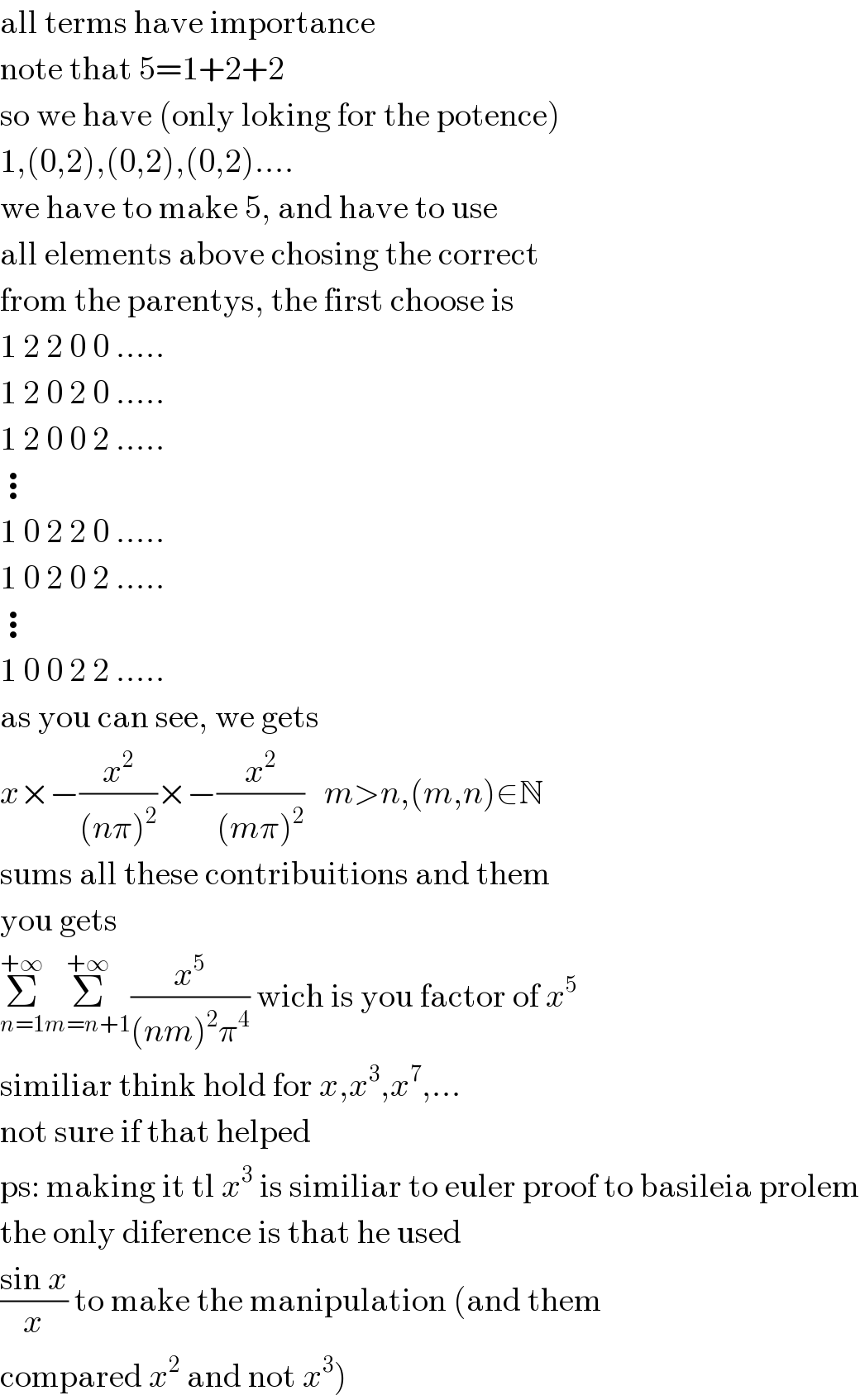
$$\mathrm{all}\:\mathrm{terms}\:\mathrm{have}\:\mathrm{importance} \\ $$$$\mathrm{note}\:\mathrm{that}\:\mathrm{5}=\mathrm{1}+\mathrm{2}+\mathrm{2} \\ $$$$\mathrm{so}\:\mathrm{we}\:\mathrm{have}\:\left(\mathrm{only}\:\mathrm{loking}\:\mathrm{for}\:\mathrm{the}\:\mathrm{potence}\right) \\ $$$$\mathrm{1},\left(\mathrm{0},\mathrm{2}\right),\left(\mathrm{0},\mathrm{2}\right),\left(\mathrm{0},\mathrm{2}\right).... \\ $$$$\mathrm{we}\:\mathrm{have}\:\mathrm{to}\:\mathrm{make}\:\mathrm{5},\:\mathrm{and}\:\mathrm{have}\:\mathrm{to}\:\mathrm{use} \\ $$$$\mathrm{all}\:\mathrm{elements}\:\mathrm{above}\:\mathrm{chosing}\:\mathrm{the}\:\mathrm{correct} \\ $$$$\mathrm{from}\:\mathrm{the}\:\mathrm{parentys},\:\mathrm{the}\:\mathrm{first}\:\mathrm{choose}\:\mathrm{is} \\ $$$$\mathrm{1}\:\mathrm{2}\:\mathrm{2}\:\mathrm{0}\:\mathrm{0}\:..... \\ $$$$\mathrm{1}\:\mathrm{2}\:\mathrm{0}\:\mathrm{2}\:\mathrm{0}\:..... \\ $$$$\mathrm{1}\:\mathrm{2}\:\mathrm{0}\:\mathrm{0}\:\mathrm{2}\:..... \\ $$$$\vdots \\ $$$$\mathrm{1}\:\mathrm{0}\:\mathrm{2}\:\mathrm{2}\:\mathrm{0}\:..... \\ $$$$\mathrm{1}\:\mathrm{0}\:\mathrm{2}\:\mathrm{0}\:\mathrm{2}\:..... \\ $$$$\vdots \\ $$$$\mathrm{1}\:\mathrm{0}\:\mathrm{0}\:\mathrm{2}\:\mathrm{2}\:..... \\ $$$$\mathrm{as}\:\mathrm{you}\:\mathrm{can}\:\mathrm{see},\:\mathrm{we}\:\mathrm{gets} \\ $$$${x}×−\frac{{x}^{\mathrm{2}} }{\left({n}\pi\right)^{\mathrm{2}} }×−\frac{{x}^{\mathrm{2}} }{\left({m}\pi\right)^{\mathrm{2}} }\:\:\:{m}>{n},\left({m},{n}\right)\in\mathbb{N} \\ $$$$\mathrm{sums}\:\mathrm{all}\:\mathrm{these}\:\mathrm{contribuitions}\:\mathrm{and}\:\mathrm{them} \\ $$$$\mathrm{you}\:\mathrm{gets} \\ $$$$\underset{{n}=\mathrm{1}} {\overset{+\infty} {\sum}}\underset{{m}={n}+\mathrm{1}} {\overset{+\infty} {\sum}}\frac{{x}^{\mathrm{5}} }{\left({nm}\right)^{\mathrm{2}} \pi^{\mathrm{4}} }\:\mathrm{wich}\:\mathrm{is}\:\mathrm{you}\:\mathrm{factor}\:\mathrm{of}\:{x}^{\mathrm{5}} \\ $$$$\mathrm{similiar}\:\mathrm{think}\:\mathrm{hold}\:\mathrm{for}\:{x},{x}^{\mathrm{3}} ,{x}^{\mathrm{7}} ,... \\ $$$$\mathrm{not}\:\mathrm{sure}\:\mathrm{if}\:\mathrm{that}\:\mathrm{helped} \\ $$$$\mathrm{ps}:\:\mathrm{making}\:\mathrm{it}\:\mathrm{tl}\:{x}^{\mathrm{3}} \:\mathrm{is}\:\mathrm{similiar}\:\mathrm{to}\:\mathrm{euler}\:\mathrm{proof}\:\mathrm{to}\:\mathrm{basileia}\:\mathrm{prolem} \\ $$$$\mathrm{the}\:\mathrm{only}\:\mathrm{diference}\:\mathrm{is}\:\mathrm{that}\:\mathrm{he}\:\mathrm{used} \\ $$$$\frac{\mathrm{sin}\:{x}}{{x}}\:\mathrm{to}\:\mathrm{make}\:\mathrm{the}\:\mathrm{manipulation}\:\left(\mathrm{and}\:\mathrm{them}\right. \\ $$$$\left.\mathrm{compared}\:{x}^{\mathrm{2}} \:\mathrm{and}\:\mathrm{not}\:{x}^{\mathrm{3}} \right) \\ $$
Commented by Rasheed Soomro last updated on 01/Dec/15

$$\mathcal{T}{his}\:{don}'{t}\:{require}\:{only}\:\left({a}−{b}\right)\left({a}+{b}\right)={a}^{\mathrm{2}} −{b}^{\mathrm{2}} \\ $$$${This}\:{is}\:{some}\:{what}\:{difficult}. \\ $$$${Anyway}\:\mathcal{THANK}^{\mathcal{S}} \:{for}\:{explanation}\:{in}\:{detail}. \\ $$$$\mathcal{I}\:{will}\:{try}\:{my}\:{best}\:{to}\:{understand}\:{it}. \\ $$
Commented by 123456 last updated on 02/Dec/15
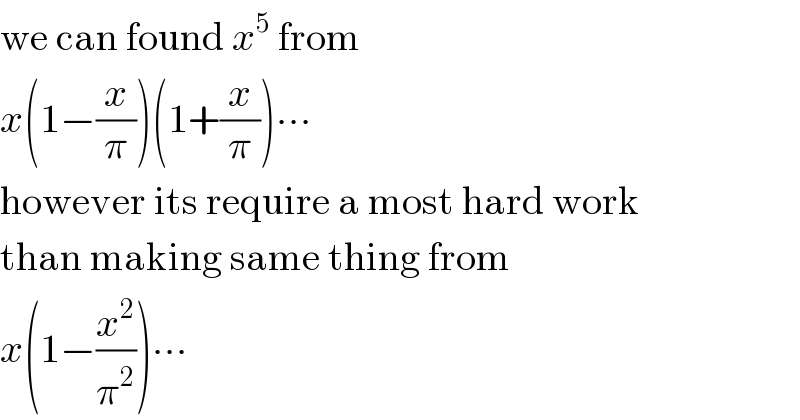
$$\mathrm{we}\:\mathrm{can}\:\mathrm{found}\:{x}^{\mathrm{5}} \:\mathrm{from} \\ $$$${x}\left(\mathrm{1}−\frac{{x}}{\pi}\right)\left(\mathrm{1}+\frac{{x}}{\pi}\right)\centerdot\centerdot\centerdot \\ $$$$\mathrm{however}\:\mathrm{its}\:\mathrm{require}\:\mathrm{a}\:\mathrm{most}\:\mathrm{hard}\:\mathrm{work} \\ $$$$\mathrm{than}\:\mathrm{making}\:\mathrm{same}\:\mathrm{thing}\:\mathrm{from} \\ $$$${x}\left(\mathrm{1}−\frac{{x}^{\mathrm{2}} }{\pi^{\mathrm{2}} }\right)\centerdot\centerdot\centerdot \\ $$
Commented by Rasheed Soomro last updated on 02/Dec/15

$$\mathcal{O}{f}\:{course}\:{sir}! \\ $$
